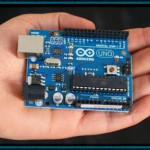Welcome to my digital home! There are lots of articles you might find helpful buried in this site on topics such as modifying an Alfa Romeo 159, rebuilding a Lotus 7 (Robin Hood 2B), not to mention a ton of stuff on technology in general. It’s all here somewhere, so use the search function or navigate using the menu structure. if you want to talk, reach out via the contact function, I usually do answer!
Random Post Selection
GeneralThe Problem:
Ok, so anyone who has worked with sound equipment before would have been greatly disappointed shortly after taking the M-Audio Xponent out of the box. Essentially, it’s a bit crap. The main bug-bears are the faders, often referred to as being made by “Fisher Price”.They are loose, and generally feel nothing like a proper mixer, so anyone used to using pro audio equipment is going to feel short changed (I know I did!). That said, once you get over them, and there are some tricks you can apply to make them feel less annoying, the other primary bug-bear is Torq. This software can only be described as an epic fail! I gave it a shot, I persevered with it for a long time, and have come to the conclusion that its beat detection engine was programmed using chaos theory.
I have mixed on many different platforms, decks (belt and DD), CDJ’s (from first gen to modern) and midi software from TraktorScratch V1.0 through to the usual suspects of today. What all of these platforms allow you to do is beat match with little effort if you’ve got a good ear. Torq on the other hand, seems to want to fight this process and in my own experience, creates a clinical/harsh environment to align beats without getting nasty overlay (beat on beat cancelation). If you persevere I am sure you can personally compensate for this and actually become good at “mixing with Torq” but IMO I don’t think it appropriate to change my mixing style after 20 years just to accommodate crap software.
This problem brings us to the solution I have discovered. I don’t take credit for pulling this together, many people better than me have toiled long and hard to make this work and have done some excellent work on the subject. All I wanted to do was have a rant, show you how easy it is to make the Xponent better and then credit those who did the work.
The Solution:
Native Instruments have invested a lot of time and energy into refining the Traktor product to what it is today. I have used different iterations of it since Scratch v1.0 (the first ever version) and it just keeps improving! The most recent version is Traktor Pro V1.x, I am using 1.2.4 and it is truly phenomenal. I won’t go into it in too much detail, but will say this much, its intuitive, just like it should be, has some amazing effects available out of the box and “just works perfectly” What more could you ask for?
Of course, Despite the Xponent being a Midi Control Surface and a Sound Card, it’s been locked into Torq to proliferate the spread of the evil program, but, there is a way you can break out of this and turn your midi control surface back into a programmable 2-way midi surface like any other. It’s actually quite simple:
While you switch the device on, press and hold the number 2 Queue button + the Lock Button on the left deck. It’s that simple, hold them till it’s all booted up, and to check its worked, press any button, if it lights up then fades away, it’s not worked and you need to power off and try again. If it does not light up, you’re in business and you have a midi control surface ready to use with any Digital DJ software you want!
At this stage you have a couple of options, start mapping the buttons yourself or grab a map that has already been put together. Personally, I like to short-cut things, so I would grab a predesigned map. After a good look around and a few failed starts, I found a mapping from HolyCT based on the work of DJ Kad listed in the NI Forums. It is amazing! It has all the mappings you would want, full documentation and even a browser mode so you can use the jog wheels to browse your track lists without the keyboard and mouse! It makes use of the X/Y Pad and is IMO a very well put together map for the Xponent.
Bringing the good features from the Xponent to a well written and user friendly piece of software like Traktor Pro, is a marriage made in heaven! I am truly blown away with the usability and playability of the combination, and it has convinced me to stick with my Xponent for the time being. It may not be the best controller in its class, but it has some cool features and once you get used to the faders, it’s not all bad!Related Images: [...]
InfoSecI am getting a little annoyed with hearing people wax lyrical about “the cloud” and how its going to revolutionise the world. I have a news flash for you all, its not new and its not revolutionary!
First of all, lets define what we are talking about. There is a simple definition for Cloud Computing, and three models of operation as held by NIST, these are:
Definition:
Cloud computing is a model for enabling convenient, on-demand network access to a shared pool of configurable computing resources (e.g., networks, servers, storage, applications, and services) that can be rapidly provisioned and released with minimal management effort or service provider interaction. This cloud model promotes availability and is composed of five essential characteristics, three service models, and four deployment models.
Models of Operation:
Cloud Software as a Service (SaaS). The capability provided to the consumer is to use the provider’s applications running on a cloud infrastructure. The applications are accessible from various client devices through a thin client interface such as a web browser (e.g., web-based email). The consumer does not manage or control the underlying cloud infrastructure including network, servers, operating systems, storage, or even individual application capabilities, with the possible exception of limited user-specific application configuration settings.
Cloud Platform as a Service (PaaS). The capability provided to the consumer is to deploy onto the cloud infrastructure consumer-created or acquired applications created using programming languages and tools supported by the provider. The consumer does not manage or control the underlying cloud infrastructure including network, servers, operating systems, or storage, but has control over the deployed applications and possibly application hosting environment configurations.
Cloud Infrastructure as a Service (IaaS). The capability provided to the consumer is to provision processing, storage, networks, and other fundamental computing resources where the consumer is able to deploy and run arbitrary software, which can include operating systems and applications. The consumer does not manage or control the underlying cloud infrastructure but has control over operating systems, storage, deployed applications, and possibly limited control of select networking components (e.g., host firewalls).
Now, I am pretty sure that during my long career, I have seen a lot of companies doing IaaS and PaaS as a “Business as Usual” activity, haven’t you? In my experience, IaaS is nothing more than a traditional infrastructure outsourcing arrangement, as undertaken with IBM, HP/EDS or BT, while PaaS is just a simple hosting service offered by most ISP’s (I accept I am simplifying here). So what are we really talking about when the press pickup and pedal the term “cloud computing”. Looks to me like they are talking about SaaS, which again, has been around for a while, Hotmail anyone?, but not really taken off in the enterprise until it became “cloud computing”. So is this just a media spin to pedal Hotmail to the enterprise or just a natural progression from outsourcing boxes to apps? What is revolutionary here, I am yet to see.
Related Images: [...]
ElectronicsWell I finally got round to purchasing an Arduino Uno Open Source Prototyping Platform and first impressions are !WOW. I am genuinely impressed with the overall package, its flexibility and quality of the hardware and software. First off, getting up and running on your favourite OS is a breeze, with detailed step by step instructions available on the Arduino site.
Aside from the basic Uno itself:
I invested in a few extras from a UK outfit called Cool Components that sell the Arduino and plenty of shields and extras. To give me enough to start with, I picked up:
140-Piece Wire Kit
Electronic Brick Kit
Generic Starter Kit
Jumper Wires – Female to Female
Jumper Wires – Male to Female
Although in hindsight, I should have bought a few more male to male jumper cables as these seem to be the primary cable type!
Getting up and running was a breeze, remembering my basic electronics from my childhood stood me in good stead to build a small circuit, and google/youtube filled in the blanks easily!
So what did I build?
Essentially its 5 LEDs running in a sequence, with the timing controlled by an analogue rotary switch or potentiometer, as I learned it was called. It actually took longer to figure out it wasn’t called a “rotary encoder” which is apparently something very different and digital, than it did to code the entire program and build the circuit!
The circuit is simple:
…and so is the program:
/*
Jabawoki Light tracer V1.0
22/07/2011
*/
int potpin = 0;
int val;
void setup() {
pinMode(12, OUTPUT);
pinMode(11, OUTPUT);
pinMode(10, OUTPUT);
pinMode(9, OUTPUT);
pinMode(8, OUTPUT);
}
void loop() {
// Read the Analog Pot
val = analogRead(potpin);
// Switch the LEDs on
digitalWrite(12, HIGH);
digitalWrite(8, HIGH);
delay(val);
digitalWrite(11, HIGH);
digitalWrite(9, HIGH);
delay(val);
digitalWrite(10, HIGH);
delay(val);
// Switch LEDs off
digitalWrite(12, LOW);
digitalWrite(8, LOW);
delay(val);
digitalWrite(11, LOW);
digitalWrite(9, LOW);
delay(val);
digitalWrite(10, LOW);
delay(val);
}
What more could you ask for in a prototyping platform?
You can download the code and schematics for this project from the downloads section
Watch this space, I have 5 key projects I am planning once I get my head properly around this, some of which will blow your mind.
Here is some video of the project working in all its glory!
http://www.youtube.com/watch?v=K9rIHjsyiUs
Related Images: [...]
General…..after a day clearing out the garage (trust me, it needed doing), I came across the original install CD for my Stanton Final Scratch V1, which I thought was long gone. After further search through a lot of vinyl, I found the control records, which meant all that was left was to dig out the interface and hook it all up. After about 4 hours of kicking an old Compaq Laptop into shape, I had a working version of FinalScratch V1.1 up and running with a bunch of MP3’s ready to go……..
All of this equates to one simple thing, new mixes are on the way!
I had been waiting for a suitable opportunity to purchase the new Traktorscratch V3 setup, but to be honest, this works just as well. Sure, its a little clunky, very basic and quite slow, but once you get to grips with its idiosyncratic nature, it is actually quite usable.
Of course, now I have the basics back up and running, and can start to churn out some fresh mixes, which is what its all about.
Stay tuned
Pure Retro Sheek, Traktor FS V1.1 on an N800C!!!
Related Images: [...]
LiveMixeshttps://jabawoki.com/wp-content/mp3/Jabs_14092001_OldSkool_House.mp3
Podcast: Play in new window | Download
Related Images: [...]
Alfa 159Daily Power is a work in progress but boost is at 3500mbar and fuel is flowing at 130mm3 so it should be good for a solid 800NM+ as a daily driver 🙂 #noSmokenoPoke
Power:
Base Model: 2008 159 TI 2.4 JTDM QTRONIC (Diesel)
Base Power: 200bhp / 400nm @ the flywheel
Dyno Power: 317WHP / 793NM @ front wheels (with Water/Meth 500cc) @ 3200mbar
Daily Power: TBC WHP / TBC NM @ front wheels (with Water/Meth 1000cc) @ 3500mbar
The run above had a faulty water/meth controller which is why its a little jumpy!
Old Dyno Runs of when it was around 250bhp:
Dyno run 1
Dyno run 2
Dyno run 3
Dyno run 3 alternative angle
Dyno run 4
Dyno run 4 alternative angle
Engine Mods:
Blow back Recirculation Breather System re-routed to exhaust via E-Vac Scavenger and one way morroso valve
Swirl Valves fully blanked in the Manifold
Straight through Wizard exhaust with no CAT’s, no DPF and no mufflers on 4″ tails
600 x 300 x 76mm core High Flow, Front Mounted Inter-cooler with custom pipework and mounts
18 row Mocal oil cooler (235mm)
Hybrid GTB2056 Turbo (BMW 530D Gt22 Turbine Conversion, 62mm Extended tip billet Compressor Wheel with 4mm extended tips and 49.60mm inducer “62 trim”, Blueprinted, staggered gap oil seals on exhaust side, 15 degree cutback / clipped turbine wheel and 63mm custom intake adapter)
4bar TMAP sensor
80mm BMC CDA direct to turbo on custom 2ft pipe run for maximum de-restriction
Water Methanol System (AEM Pump & 1000cc/min nozzle + Devils Own 100psi/7bar Progressive Controller)
Inline OIL sensor reservoirs on Engine and Gearbox
Inline Mocal thermostatic control valve on gearbox oil cooler
All ECU Mapping work courtesy of Jacekowski and Jabawoki.
Handling Mods:
255/40/19 Vredestein ULTRAC Vorti Tyres
Spacers on wheels to stance / prevent rub!
Autolusso Braided Brake Lines
Performance Friction Brake Pads @ Front
EBC Yellow Brake Pads @ Rear
MTEC Groved, Vented & Dimpled Discs with Black Treatment all round
ATE TYP200 Racing Brake Fluid
Bilstein B12 Pro Suspension Kit (B6 Shocks & Eibach Springs)
Powerflex Front Upper and Lower Bushes
Modified upper arms with greese nipples
New 330mm Brembo calipers
Lighting Mods:
H7 LED’s for Driving & Main Beam including custom dust caps
Full External LED Conversion
Full Internal LED Conversion
Cylon High Level LED brake light
Project Halo – Tri-Halo DRL Conversion
Electrical Mods:
16v 83.333F Super Capacitor Bank on primary electrical system
230v AC Socket in Glovebox
Twin Digital Temp Gauge (Engine and Gearbox Oil) in air vent mount
secondary fused distribution boxes under dash and in engine bay for ancillaries
All wiring and ancillary systems wrapped to look stock.
Gearbox Radiator Cooling System
100Amp Shunt and Volt / Ammeter from Capacitor Bank to Battery
Multiple 2.2amp USB sockets and feeds for general convenience!
Under Bonnet Temperature Sensor / Gauge
Audio Mods:
Custom Sub Enclosure with 12″ Infinity KAPPA Perfect 12VQ M3D Sub
Fully Soundproofed
Modified Alpine MRV-T420 Amplifier
Custom Wiring
Pioneer AVH-X5700DAB
FM/AM/DAB+/GPS Aerial Mod
Visual Mods:
Fog Lights removed from front bumper and re-grilled for greater air flow to additional radiators
Latest Gen Badges all round
Some stickers:
Cloverleafs …because race car.
Nurembergring Sticker …because she’s been 🙂
“Built Not Bought” …because she is.
” order_by=”sortorder” order_direction=”ASC” returns=”included” maximum_entity_count=”500″]
Related Images: [...]
LiveMixesIn honour of the legend that is Deadmau5 this mix is dedicated to his work and the awesome sounds that result from it.
01) Toca Me (Deadmau5 mix) – Fragma
02) I Want You (Deadmau5 mix) – Carl Cox
03) Afterhours – Deadmau5 & Mallefresh
04) Hey Baby – Deadmau5 & Mallefresh
05) Harder Better Faster on Drugs – Deadmau5 vs Daft Punk
06) Dont You Want To Feel (Deadmau5 mix) – Drugstore Era
07) Finished Symphony (Deadmau5 mix) – Hybrid
08) Tiny Dancer (Deadmau5 mix) – Marco Demark Feat Casey Barnes
09) Longest Road (Deadmau5 mix) – Morgan Page
10) Super Skunk (Deadmau5 mix) – Noir
11) Cherry Twist (Deadmau5 mix) – The Crystal Method
12) Dirty Sexy Club Music (Deadmau5 mix) – Filter Freq
13) Burn (Deadmau5 mix) – Prime 33
14) No Pressure (Deadmau5 mix) – One Plus One
15) God Is A DJ (Deadmau5 mix) – Faithless
https://jabawoki.com/wp-content/mp3/Jabawoki_Strictly_Mau5_04042011.mp3
Podcast: Play in new window | Download
Related Images: [...]
InfoSecWhich Penetration Testing Qualification is best from a client perspective:
Which Penetration Testing Qualification is best from a Testing perspective:
(NB: I have deliberately excluded “accreditation schemes” such as CREST and CHECK)
Related Images: [...]
Alfa 159Once the planning was complete and I had the Amp prepared for some serious load, it was over to the car for a complete strip of the boot and sound proofing. The approach taken was to utilise a number of different sound proofing materials once I stripped the car back to the shell.
To start with , a Bitumen material was used to create a panel deadening effect to eliminate rattles and vibrations. This was applied to all panels in as much quantity as was viable. The second stage was to utilise a 12mm thick high density foam to act as a sound proofing material. This was used to create a sound proof shell in the boot to stop the low frequencies going anywhere but into the cabin, as such, this material was not used on the parcel shelf, where the bitumen product was, but was utilised on every other surface that was externally facing. Where it was just not possible to utilise the thick 12mm foam, I made use of a 7mm medium density foam that was more pliable and easier to work with.
” order_by=”sortorder” order_direction=”ASC” returns=”included” maximum_entity_count=”500″]
Related Images: [...]
RH2B Build DiaryThe first job on the agenda for the Hoody was to fix some rather terrible intake trumpets! The independent Throttle Bodies that were installed onto the engine are, well, how do I say this….. a bit shit. While there is a long term plan around changing these I needed a better short term solution to a specific problem. The trumpets kept falling off!
Reading the original build diary there is a sentence that reads “Modified Maplin Speaker trumpets as air intakes”. That should be enough to make you shudder, it did me! So first things first was to fire up Fusion 360 and get to work with the vernier calipers!
After several iterations I found a design that worked. It has sufficient grip inside the intake to hold itself steady and a small ridge around the outside to stabilize itself. There was of course no where to bolt or secure an intake trumpet to as these ITB’s were once a dellorto carburetor and twice as long. (The builder literally cut them in half!) I had to design two types of intake as one of the 4 had to accommodate an air temperature sensor, but it was a simple enough modification once I had a good base design.
4 3d printed trumpets ready for installation.
Several printed iterations, as well as some R&D into the right type of material to print the final versions in was necessary. In the end I opted for an engineering Grade Carbon Fiber infused Nylon composite from Novamid. This material boasted a very high heat deflection temperature, extreme strength and nearly zero shrinkage whcih was ideal for my situation. It wasn’t cheap stuff though!
All in all the project took a while due to 1) me learning new skills in Fusion, 2) learning how to print composite materials and 3) modifying my printer to cope with the composites. That said, it was thoroughly enjoyable!
Related Images: [...]








